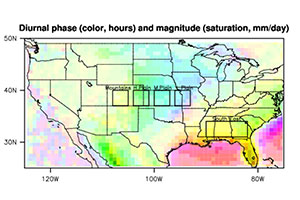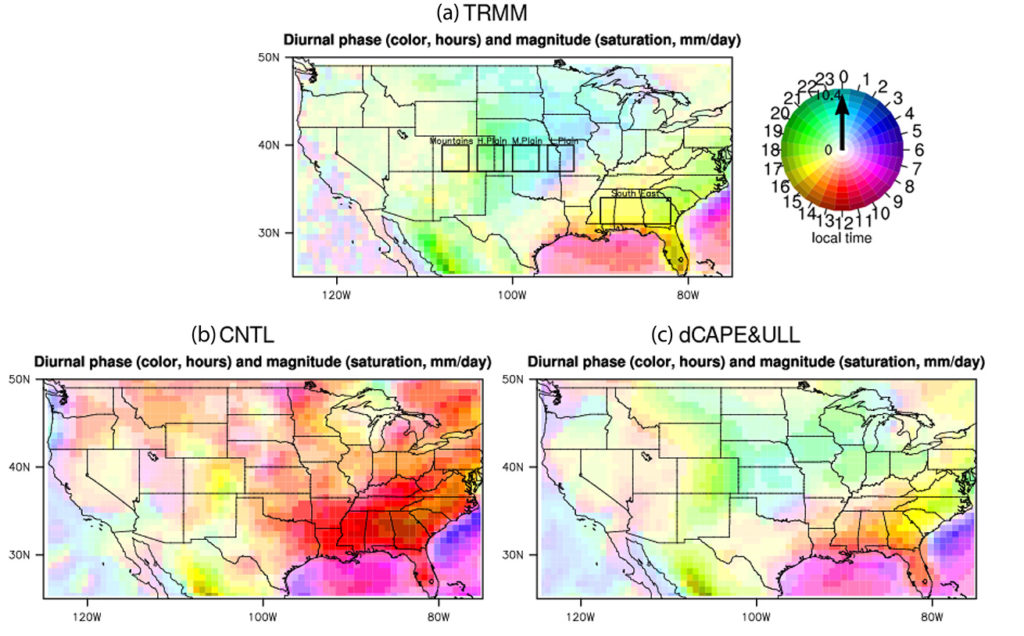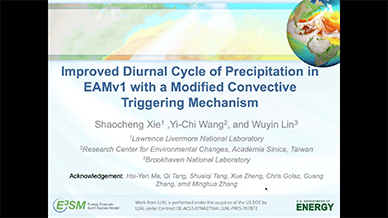Modeling of Precipitation Diurnal Cycle Improved

AGU recently selected work led by E3SM scientists on improving the modeling of the diurnal cycle of precipitation in climate models as an EOS Research Spotlight. The original study by Xie et al., appeared in the June 22, 2019 issue of the Journal of Advances in Modeling Earth Systems (JAMES). The researchers propose a new convective triggering mechanism that controls when and where convection occurs in E3SM to address two common climate model biases in simulating the diurnal variation of precipitation: models tend to rain too early during the day and almost all current climate models fail to capture the nocturnal rainfall peak that is common in many areas like the Great Plains. The nocturnal rainfall peak primarily results from nocturnal elevated convection associated with the eastward propagating meso-scale convective systems originating over mountain ranges.
For the first model bias problem – modeled rain occurs too early in the day – the authors introduce a dynamic constraint, referred to as the dynamic Convective Available Potential Energy (dCAPE), for preconditioning of the convection-favoring environment to establish and prevent CAPE from being released spontaneously. The dynamic constraint (dCAPE) relaxes the strong coupling of convection to surface heating, which is believed to be one of the major reasons for the model bias, and allows CAPE to be accumulated for later and stronger convection.
For the second model bias problem – failure to capture the nocturnal rainfall peak – the authors implement the Unrestricted air parcel Launch Level (ULL) scheme to remove the constraint that convection always has its root within the boundary layer, as is often assumed in many deep convection schemes. Using ULL allows atmospheric instability above the boundary layer to be detected for capturing nocturnal elevated convection systems.
In the figure above, the satellite observations (TRMM) show late afternoon to early morning peaks (1600 Local Standard Time (LST) to 0200 LST) over most of the contiguous U.S. For example, precipitation peaks at late afternoon (1600 LST) in the southeastern U.S. while the precipitation maximum features an eastward propagation from the eastern edge of the Rocky Mountains at late afternoon to the central Great Plains at midnight (105 degrees W to 90 degrees W). The default E3SM Atmosphere Model v1 (EAMv1) tends to produce precipitation too early during the day and fails to capture the nocturnal peak over the Great Plains. These model biases are dramatically reduced with the revised convective trigger. The nocturnal peak over the Great Plains, which nearly all climate models fail to capture, is well simulated with the revised trigger. The diurnal cycle of precipitation over the eastern U.S. is also much improved.
With these two changes, the E3SM model shows dramatic improvements in capturing the timing of rainfall events – especially the diurnal cycle – although the model only marginally improves the mean amount of precipitation across the entire globe. These improvements represent an important advance in modeling the diurnal cycle of precipitation in E3SM. This body of work is part of E3SM’s Next Generation Development (NGD) effort in Atmospheric Physics. The goal of the NGD is to address model shortcomings and deficiencies responsible for major model biases in clouds and precipitation in E3SM v1. For more information, see the NGD Atmospheric Physics page on the E3SM website.




